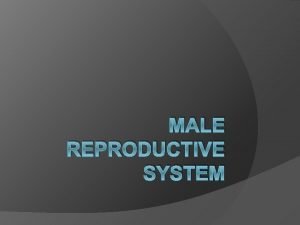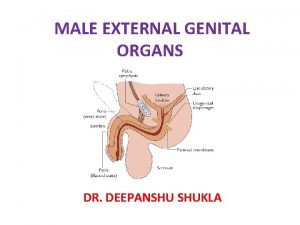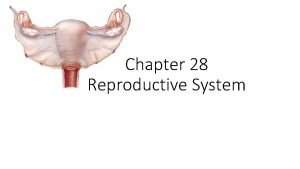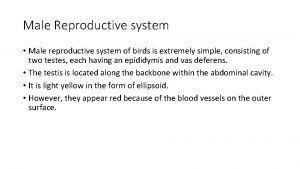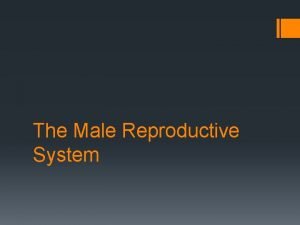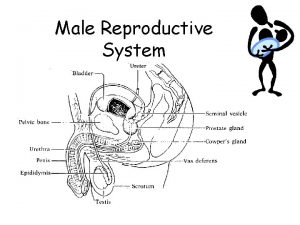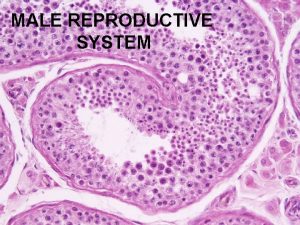Male Reproductive System Male Reproductive Anatomy Prepuce foreskin












- Slides: 12

Male Reproductive System

Male Reproductive Anatomy Prepuce (foreskin) Penis Scrotum

• Essential organs – testes (2) - one of the pair of male gonads that produce semen; suspended in the scrotum by the spermatic cords; descend at 7 months in utero into the scrotum accompanied by an evagination of muscular and connective tissue of the body wall that suspend the testes • Accessory Organs – Genital ducts – send sperm to outside of body • • epididymis (2) vasa deferens (2) ejaculatory duct (2) urethra • Accessory Glands – produce secretions that nourish, transport and mature sperm – seminal vesicles (2) – prostate – bulbourethral (2) • Supporting structures – scrotum – penis – spermatic cords (2)


Vas deferens Corpus cavernosum Corpus spongiosum

Spermatogenesis Spermatogonia mitosis Primary spermatocytes meiosis Secondary spermatocytes meiosis Spermatids epididymis Spermatozoa (motile)

Male Reproductive Cycle • • Organ development in utero; testes descend into scrotum at 7 months in utero Reproductive function at puberty – high hormone levels stimulate final stages of development – Sperm production • Spermatogenesis mitosis meiosis spermatogonia primary spermatocytes secondary spermatocytes meiosis spermatids spermatozoa (motile) • Sperm – Produced in seminiferous tubules when reach puberty – Spermatids mature to spermatozoa in epididymis – There about 200 -500 million of those little guys in the average amount of semen produced each time a man ejaculates. – It takes 10 weeks for a single soldier to reach maturity. – Mature sperm can live up to 2 weeks in the epididymis – Healthy males produce about 70 -150 million sperm a day

Spermatozoa o. Acrosome - resembles a toque which covers the upper portion of the head of the sperm. The covering contains enzymes that help the sperm penetrate the egg. o. Head – contains the 23 chromosomes (genetic material) capable of merging with an egg to produce a new individual. o. Midpiece – connects the head of the sperm to the tail. It contains many mitochondria that produce ATP. This ATP is used to move the microtubules in the tail and create propulsion for the sperm. Once in the female system, sperm will "swim" for up to 2 days looking for an egg. o. Tail - flagellum with microtubules. The microtublues within the tail move past each other and move the tail in a whip-like motion. ATP provided by the midpiece is required for this movement. Acrosome

Pathway of Sperm 1. Sperm travel from the testes 2. to the epididymis where they mature 3. During ejaculation sperm travel up into the abdomen from the epididymis in the vas deferens to the ejaculatory ducts. 4. The ejaculatory ducts move semen into the urethra. Once in the urethra, semen (sperm now is bathed in the seminal fluid released from the various other reproductive structures) moves through the 5. prostate gland down to the urethral opening at the tip of the penis. 6. The seminal vesicles and bulbourethral glands are not included in the path of sperm as they contribute to seminal fluid but do not have sperm moving through them at any time.

Seminal Fluid (Semen) • Semen • Sperm – 10% • Fluid – 90% • Semen only contains about 10% sperm - the rest consists of enzymes, vitamin C, calcium, protein, sodium, zinc, citric acid and fructose sugar. • Produced from 3 glands • Seminal vesicle – 60% of seminal fluid oyellowish fluid rich in nutrients (fructose) • Prostate – 30% of seminal fluid ospongy, secretes milk, alkaline fluid • Bulbourethral – 10% of seminal fluid othin, clear mucus that neutralizes p. H of urine and lubricates

Fertility • Factors: – – • sperm count sperm size sperm shape sperm motility Infertility – – – caused by antibodies some men make against own sperm less than 20 million/m. L of semen Some things that may reduce sperm number and/or quality include: • alcohol, drugs, environmental toxins, including pesticides, smoking cigarettes, health problems, medicines, radiation treatment and chemotherapy for cancer, age

Male Reproductive Hormones Gn. RH – gonadotropin releasing hormone LH – leutinizing hormone FSH – follicle stimulating hormone Hypothalamus Gn. RH Pituitary LH FSH Testes Testosterone Sperm testosterone – secreted by Leydig cells • develop and maintain secondary sex characteristics • regulate metabolism; known as anabolic hormone • stimulates protein anabolism to promotes bone and muscle growth • early maturation leads to epiphyseal closure • late maturation, delayed epiphyseal closure • fluid and electrolyte metabolism • inhibits anterior pituitary secretion of gonadotropins (FSH and LH) https: //www. youtube. com/watch? v=-XQcn. O 4 i. X_U https: //www. youtube. com/watch? v=v 22 Cj. FYizi 0
 Pure soul spirituality
Pure soul spirituality Prepuce
Prepuce Prepuce
Prepuce What does the seminal vesicle secrete
What does the seminal vesicle secrete Redundant prepuce phimosis and paraphimosis
Redundant prepuce phimosis and paraphimosis What does the prostate do
What does the prostate do Function of the vagina
Function of the vagina Male function
Male function Development of female reproductive system
Development of female reproductive system Exercise 42 anatomy of the reproductive system
Exercise 42 anatomy of the reproductive system Lutalphase
Lutalphase Female anatomy
Female anatomy Male fallopian tube
Male fallopian tube

